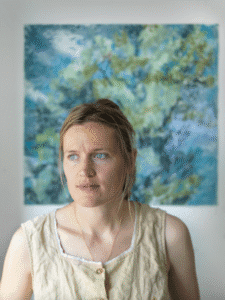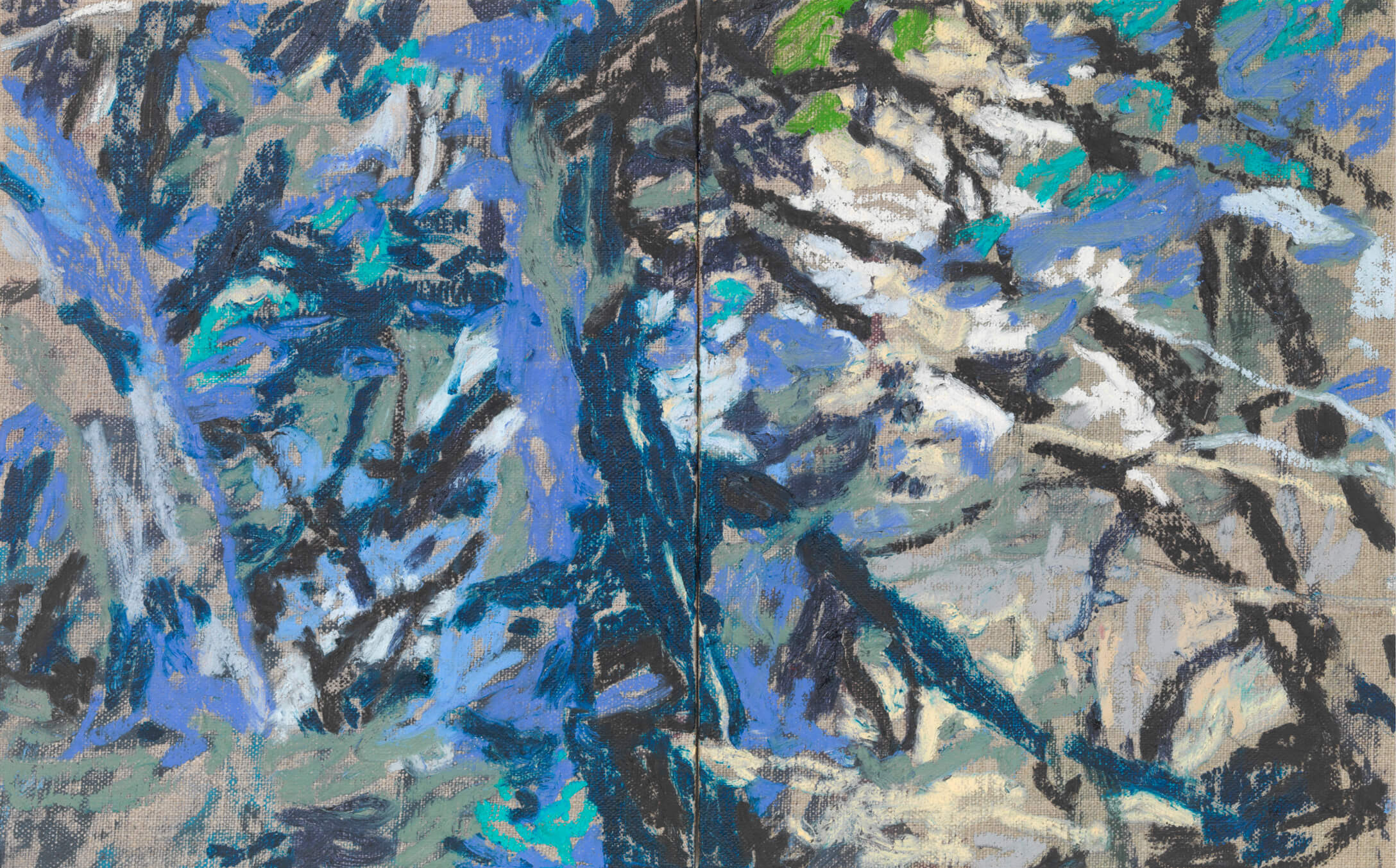by Tamara Colchester, July 2025
Experiences of nature are fleeting. They can impress us and linger in our senses, but we cannot keep what is always moving, changing, dying and growing.
Tyga Helme does not attempt to capture the landscapes or plants she paints, instead she holds a glimpse as Ted Hughes wrote, of a multitude of moments. By her attentional effort we are offered an intimate encounter with the natural world. Much like the interplay of light through leaves, we see in these images a world that is dancing. For a moment we are caught in the movement.
Helme strikes me as an unusual artist in today’s self-referential world. Her gaze does not objectify but relates with. She looks out into the world with animal focus until she, and we, are absorbed into it. ‘When I spend a long time painting brambles,’ she says, ‘I start to dream of them, almost become them.’ The intensity of her gaze allows her to blur her own boundaries. ‘Painting,’ she says, ‘is about drawing the landscape in.’
 Helme’s past work has centred on chalk painting and drawing, but for this show she wanted to explore oils, retaining the smooth wood or the milky, transparent film panels she favours. ‘Whether chalk or oil, the sticks I use can feel awkward and childlike – they force you to be out of control.’ They also allow her to work quickly, revealing the ground of each painting whose subtle colours are decided on while sitting immersed in the landscape.
Helme’s past work has centred on chalk painting and drawing, but for this show she wanted to explore oils, retaining the smooth wood or the milky, transparent film panels she favours. ‘Whether chalk or oil, the sticks I use can feel awkward and childlike – they force you to be out of control.’ They also allow her to work quickly, revealing the ground of each painting whose subtle colours are decided on while sitting immersed in the landscape.
Quiet Forces, a record of painting in various woodlands in Wiltshire, Devon, Wales and Hampstead, is a series pared back in terms of colour. ‘Working with a limited palette helps to make connections between things’ Helme says, ‘and working small helped me get into the sensations of the colours.’ Helme’s close attention brings her into a state of shared perception with the environments she inhabits while working, giving rise to new ideas. This series, she says, ‘held my hand while doing the other works.’
The ground of these paintings does not denote absence of form, rather it reveals an artist’s commitment to accurately recording her encounters. ‘I’m not making a picture, I’m just making sure that each moment I’m responding to is truthful. If my eye glances over it, I don’t want to fill the space. Every mark needs to be felt and experienced.’ The paintings are like maps of reciprocal experience, each one a visual echo of intimate engagement.
The works upend a human-centred sense of scale. The smallest paintings are of large trees and the largest of intricate foliage. The viewer experiences an artist’s gaze that both rests and penetrates, changing our perspective as ‘the big becomes small and the small becomes big.’ Helme invites us to, not only observe, but also participate in reaching out into a world that wants to get inside (and change) us.
‘If you spend time with a dock leaf, it becomes really big. It becomes a whole landscape. When I think, there’s so much going on, there’s too much to make sense of, then I just start with a colour or shape, something that excites me. Shadow or light on a particular leaf. Then it starts to paint itself. You get led through it.’
These shifts in perspective are not limited to trees. Uncontainable Night, depicting crows flying over a Welsh valley, was painted amidst a cacophony of roosting birds. ‘There were so many flying around, and I was thinking about what they see. In order to even begin doing that I needed to let myself lose control.’
For her bigger series, such as Upward Weaving, she decided to maintain working with panels so that she could let the painting grow in whichever way it wanted to. ‘Each panel is part of a wider whole.’ Helme says. ‘I know they’re going to grow, but I don’t know in which direction.’ As a viewer of these works, we are left with a sense of liberating open-endedness. The trees go on; the sky goes on. Nothing has been falsely contained by the border of the painting.
Helme allows herself to paint into the unknown, feeling her way into each unfolding moment. ‘I have no idea how they’re going to work.’ One panel and then the next, the paintings grow, led by the observed form. ‘Panels are practical too,’ she says. ‘I can take them out with me. With a big canvas it’s hard to retain the intensity and feel all the marks.’
Helme’s work reminds us that all creation emerges in a birthing process. ‘When I find an edge it’s interesting. At the start I never know where that edge is going to be. And things change in the course of a day, let alone a week. They grow, collapse. The time of the day reveals new things, and your emotional state is also changing.’
Remembering things you didn’t know you’d forgotten charts this traversing of inner and outer worlds. There are ‘moments of ease and awkwardness. I wanted it to keep going and growing but I felt like I had to stop somewhere.’ Like a meandering walk, Helme lets her eyes and hands wander, evoking wonder with the results.
Ours is a sight-dominated world, with landscape and natural form often reduced to surface image. Helme resists this trend. ‘I’m trying to do what a camera can’t. I notice the sounds and the temperatures, and I think about touch and how things feel. I enjoyed working in oil as I was able to convey a softness that echoes the softness of many leaves.’
It has been some time since Helme included figures in her landscapes. ‘Birds and moths have made appearances’, but ‘this year, human presence arrived.’ The eye is drawn to the relationship between the figures, whose relationship could be destructive or loving, and beyond it their environment into which they almost disappear. In Helme’s work, trees figure with human presence and her figures meet and merge with their surroundings.
If trees could paint, I would wager this is what they would paint. Recalling the work of Tim Knowles, who attached pencils to tree branches to see what marks they made, the elliptic figures that appear in Between darkening trees, Held and Twisted (held) might be a record of how we appear to the trees – ambiguous creatures who alter at the speed of light. In these paintings that ‘happen without too much thinking,’ we witness human experience meeting and merging with the woods. Our complex stories of passion, solitude and sorrow are painted into the world rather than set against it.
As representations of nature become ever more alluring, Helme’s work gently reminds us that our relationship with our environment is an embodied experience. We do not need to imagine the world when we can see, touch and taste it. These paintings allow us to experience the vivifying charge of lived connection in a culture of ever-accelerating artificiality.
Guided by Nan Shephard, whose poem Embodiment contains the words that make up the title of the show, Helme recognised that the way into creating this work would be from a point of stillness. ‘Her encouragement to go and be, rather than go and do, was so helpful.’ The work that emerges is not a record of falsified perfection; rather, seeing the world and ourselves as we are. ‘It has to feel awkward,’ says Helme. ‘Like the life going on inside you. The knots and the tangles are the best bits.’
